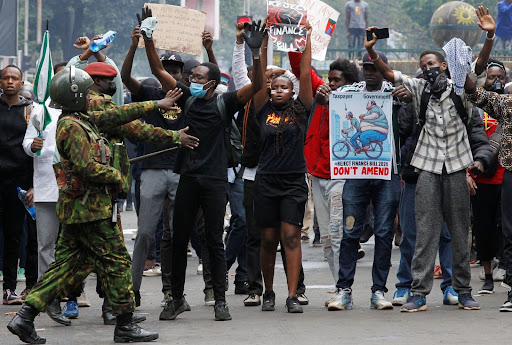The Scene
NAIROBI — Mainstream media coverage of the youth-led protests in Kenya is being overshadowed by protesters’ use of social media to shape narratives about the finance bill they oppose through shared videos, photos, memes and live streams.
TikTok and X have become the go-to platforms for many Kenyans looking to keep up with the protests, reflecting the composition of the movement itself. The protests so far have featured mostly Gen Z and millennial protesters in a country with relatively high internet access rates and widespread smartphone usage. Notably, around 75% of Kenya’s population is under 35 years of age, and the median age is 19.
On Saturday, a space organized by protesters on X recorded 60,000 live listeners at one point, a Kenyan record, and 1.2 million total views. Protesters used the seven-hour space to discuss the bill and protests so far, coordinate further action and demand the release of arrested protesters. It offered a glimpse into just how important these platforms have become as a way for protesters to maintain control of the conversation.
Countless protest-related videos have gone viral on TikTok before being widely reshared on other platforms. This lines up with new data from the Reuters Institute 2024 Digital News Report which found Kenya leads the world in terms of consumption of short-form video news content by share of population, with 94% of Kenyans consuming short-form online news videos at least once a week.
Protesters say the sharing of videos also helps protect them from police violence. “We don’t just record because it’s cool or fun, we need to record to keep ourselves safe from police brutality,” said Waiguru Githinji, a protester who recorded TikTok videos during protests in Eldoret, western Kenya on Thursday. But it has also enabled protesters to boost camaraderie and morale among activists, with fun and creative videos, such as those of dancers, creators and artists at the protests going viral.
The protesters have also sought to shape media narratives by calling out what they consider to be misreporting. Local and international media platforms, including Citizen TV and the BBC, are among outlets that faced significant backlash online over coverage relating to the protests. To their credit, however, legacy media houses in Kenya have retained their status as trusted sources of news during the protests. Major TV stations have all offered wall-to-wall live coverage of the protests, with numerous impactful interviews and moments.
Know More
The protest movement was birthed online, with citizens rallying together on X to oppose controversial tax hike proposals. They shared phone numbers of lawmakers and IMF officials, and spammed them with thousands of messages urging them to reject the Finance Bill, before ultimately taking to the streets this week in cities and towns across the country.
On Thursday, a majority of MPs voted to pass the bill despite escalating protests. They had earlier dropped a number of unpopular proposals of the bill in response to mounting public pressure. One of the movement’s strengths so far has been its organic nature, with many regular Kenyans, activists, influencers and celebrities creating different forms of content and sharing calls to action. The hashtag #RejectFinanceBill2024 had recorded over 1.4 million tweets as of Thursday.
The finance bill, first tabled for reading by parliament in May, proposed removing VAT exemptions on bread, tax hikes on mobile money transfers, and a new annual tax on motor vehicles. It prompted widespread criticism from the public. Even though several of the original proposals have been dropped activists are insisting that the entire bill be scrapped and are likely to continue protests if not.


